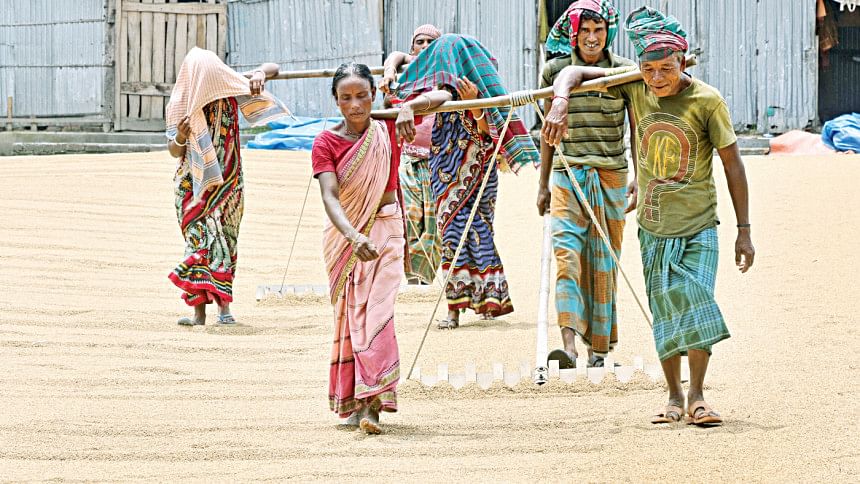Role of agriculture in Bangladesh’s economic growth

After independence, the agriculture sector was Bangladesh's main economic driving force. Its contribution to GDP was around 60 percent. Agriculture in Bangladesh is vital for people's livelihood, employment, and contributing to GDP; we all know that. Its contribution has reduced over the last decade, going from 17 percent in 2010 to 12.6 percent in 2020. The sector is at the centre of our economy, decreasing poverty and ensuring food security. However, with the ever-growing population, going from 147.6 million in 2010 to 164.7 million in 2020, added by the blow of the pandemic and climate change, the sector has continued to be resilient in terms of profitability and productivity.
I still remember international organisations referring to food riots in Bangladesh back in 2007-2008, but we have beaten their assumptions and proved them absolutely wrong; the same way, during Covid-19, agriculture as an individual sector has contributed and supported the people and state of Bangladesh relentlessly. Bangladesh is one of the most densely populated countries globally, with a density of 1,239.7 people living per square kilometre (2018)—its land is decreasing as population grows rapidly. The characteristic of a modern economy is to grow through the industrial and service sectors. This has been observed gradually in the farming sector as well. The economy has also been integrated with the global economy. We have been on the road to a self-reliant growth effort that has become a great example in the world.
The GDP contribution came down for mainstream farming, while the service and industry sector's contribution increased as people started migrating to the cities from the villages. The service sector was added to the farming sector. Only the mainstream farming sector was regarded as the main source of economic development. Afterwards came the sub-sectors of farming. On the one hand, we could see the boom in food grain production, especially due to rice varietal developments, and on the other hand fisheries, poultry, livestock and dairy turned into huge economic source. All these sub-sectors started taking shape as commercial farms in the hands of youth and progressive women entrepreneurs, not just amateur ventures. In respect to the mainstream farming sector, the GDP came down, but the significance of farming as a whole, including the sub-sectors, service and industry sectors, have increased manifold. High-value fruit orchards and vegetables also played a significant role in the economic boom. Not only the farms, but the value addition of the agricultural products came in as a booster for the agricultural service sector. Say, for example, PRAN, ACI; these huge agricultural industrial companies played a key role as well. Besides, the small scale agro-processed and agro-dependent industries played a part in the value addition.

Former Finance Minister Abul Maal Abdul Muhith used to say that, including the service and industry engaged with the farming sector, the GDP contribution of it is nearly 40 percent. Agricultural production value has increased at 3.54 percent per year in the last two decades (1999-2019). The sector remains the main source of employment, as I have mentioned earlier, providing livelihood to 40 percent of the labour force. Thus, agriculture remains the largest sector in terms of employment.
The other indirect contribution of agriculture is to provide basic raw materials for industrial processing. Immediately, jute comes to mind as an example of a product of the agro-processing industry. And at present, many agro-processing industries are fully dependent on agriculture for basic raw materials which include rice milling, sugar, tea, fruit juice, spices, etc. In the FY2020-21, the total production of grains was 455.05 lakh (45.505 million) metric tonnes, potato 106.13 lakh (10.61 million) metric tonnes, pulses 9.39 lakh metric (0.94 million) tonnes, onion 33.62 lakh (3.36 million) metric tonnes and jute 6.25 lakh (0.62 million) bales. BRRI (Bangladesh Rice Research Institute) must be credited for the grain production which has been quite remarkable. Alongside the production, the research didn't stop for a day and with responsibility, it moved ahead with the support of BARI (Bangladeshi Agricultural Research Institute). How can I not mention BINA (Bangladesh Institute of Nuclear Agriculture) as they are primarily mandated to make peaceful use of nuclear and advanced techniques to boost agricultural production and develop technologies that are environment-friendly as well as sustainable. Once upon a time, we used to import capsicum and today we're growing it here on our soil.
Now, the five-star hotels and many restaurants around the country collect foreign vegetables from inside the country, which is saving a lot of foreign currencies and many people are employed through producing such crops.
The same goes with the Qurbani season. We used to import livestock but today we're meeting this demand with our own efforts. Father of the Nation,Bangabandhu Sheikh Mujibur Rahman initiated subsidy support in farming, especially fertilisers, in his policy planning to ensure food security. It is still being followed. The infrastructure Bangabandhu built for seeds, irrigation and agricultural extension has helped us a lot. This is a huge service sector today. Most importantly BADC (Bangladesh Agricultural Development Corporation) has worked well with the high yielding variety seed, that is why Bangladesh is experiencing such crop diversity with huge productions. The question comes in, did the lifestyle or standard of the people involved with farming change? I would say, the farming sector has individually employed more than 40.6 percent people still, directly or indirectly. Previously, farmers were really poor, but today, their fates have changed with their relentless labour and definitely with quality seed support. The change has taken place because they are getting more production because of the seeds and more money than in the past. It means farmers' buying capacity has also increased. They can now feed themselves and their families, send their children to school. However, the question still rises: what is the quality of food they are eating? What is the quality of clothes they are wearing? What is the quality of education their children are receiving? We have to bring these issues into focus. If only they could get a fair price for their produce, they could have good quality life, food and clothing. The media has also played a vital role in bringing out the real facts and figures and the causes and prospects of farming and farmers over nearly 50 years. Today, with the help of mass media and also digital media platforms, a lot of farmers can share, exchange and learn from the experts and replicate the best examples or learn about the new trends and crisis inf farming.
Another aspect is the three driving forces of our economy, i.e., farming, RMG and remittance—in all these sectors, the sons and daughters of farmers are working. And they're sending money to their parents in the villages. And this money is being invested in farming, either at small scale or in large scale farming initiatives. This has not only strengthened our economy but has empowered the youth, especially the women. Moreover, agricultural tourism has opened a new door for us. I have seen in many European countries and USA the concept of the family farm. In Bangladesh, young entrepreneurs have started wonderful eco-resorts across the country and people from around Bangladesh are going to these beautiful places where they can come close to nature. There are many resorts very near to Dhaka even where you would find resorts being built, keeping the farming environment in mind so that the visitors can go and enjoy the rural setting. During the past decade, there have been so many resorts built in this manner and concept, which is really a positive approach.

Climate change is a big challenge, which we have to face with the facilitation of new agricultural technologies and adaptability. Farmers have to be provided with technologies based on their local climate change scenarios. We must come up with new seeds based on salinity and other adversities. We can't make anyone a climate refugee, rather we must try to make their life accommodating with the given changes. We must follow global adaptation technology and concentrate more on new examples of climate adaptability which fit our settings. More emphasis on agricultural mechanisation and ICT in farming should be given. This will help us to fight climate change. In the same way, we should also focus on the weather-based index, crop insurance which will ensure real empowerment of farmers and will make them more resilient. We have to make sure that new technologies of the sub-sectors of farming are being adopted and used skilfully. The challenge of the government would be to ensure that these new technologies reach the farmers, as well as the subsidies.
As the prices of the fertilisers increased across the world, the amount of subsidy has now gone up to Tk 22,000 crore (USD 2569 million). If the prices increase further, then how would the government manage equality among farmers and industries? How would they make up the fiscal gap? The course curriculum of higher studies in agriculture should be organised keeping in mind the fourth industrial revolution (4IR). Those who would train the students and farm-level officers must be able to get global-standard training (ToT) so that they can properly teach others. After completion of studies, I am sure this new generation of students could work more effectively in the field and assist the farmers with easy and handy solutions, with help of the best and most advanced technologies with government support. We must give importance to all the components of the fourth industrial revolution. Since building a "Digital Economy" is a must for implementing Prime Minister Sheikh Hasina's Vision 2041, Sheikh Hasina Institute for Frontier Technologies and hi-tech parks are being set up to develop the next generation with skills to face the 4IR. We must build our skilled human resources to handle these initiatives.
Shykh Seraj is Bangladesh's pioneer development journalist. He received the country's two highest civilian honours, Swadhinata Puroshkar and Ekushey Padak, respectively.

 For all latest news, follow The Daily Star's Google News channel.
For all latest news, follow The Daily Star's Google News channel. 



Comments